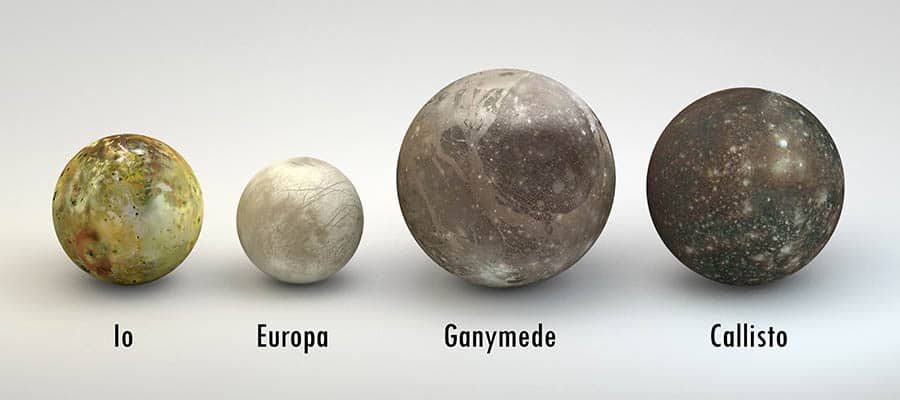13 Ganymede Moon Facts
Although many people have heard about Ganymede, they may not know all the details about it. Ganymede is one of the most well known moons because of its vast size. It orbits around the planet Jupiter, and it’s the third furthest moon from the planet itself.
And as one of the many different planets within our solar system, its cratered dark regions make it increasingly interesting for astronomers. Lets look at some interesting facts about Ganymede.

Ganymede Moon Facts
- Ganymede is the largest moon in our solar system. It has a diameter of 3,273 mi (5,268 km).
- Ganymede is actually larger than the planet Mercury, being around 10% bigger than the planet.
- However, Ganymede cannot be considered as a planet or even a dwarf planet because it orbits Jupiter.
- Like our solar system, Ganymede has likely been here since the beginning, forming around 4.5 billion years ago.
- Ganymede takes it’s name from the Trojan prince from Greek mythology.
- Ganymede orbits fully around Jupiter in around 7 days.
- Ganymede makes up one of the four Galilean moons along with Io, Europa and Callisto. They are the four largest moons of Jupiter, discovered by Galileo Galilei.
- Ganymede orbits Jupiter from a very far distance, being over 665,000 miles (1.070 million kilometers) away.
- The surface of Ganymede is often talked about. It is made up of a dark region (approximately 40%) filled with craters, and a lighter region (approximately 60%) filled with grooves and patterns.
- Ganymede is the only moon that has it’s own magnetic field like a planet does.
- Many different spacecrafts and probes have flown past Ganymede, from the Pioneer 10 in the 1970s, to Juno as recently as December 2019.
- Ganymede has an iron core, and is also made up of silicate rocks and water in the inner layer, in fairly equal amounts.
- Underneath the surface of Ganymede lies a saltwater ocean, which is just beneath the crust.
Ganymede’s Surface
This moon is well known for having two types of terrain on its surface. They’re easily distinguishable from one another, and they give the planet a unique appearance that it is pretty well known for.
Around one third of the planet is made up of dark regions across its surface. These areas of Ganymede have larger craters, which we can actually date back to occurring approximately 4 billion years ago. Across the rest of the surface of Ganymede, the terrain is significantly lighter and smoother, which is likely what the entire surface was originally like.
Common Questions about Ganymede
Where is Ganymede named after?
Ganymede takes its name from Greek mythology, named after a beautiful Trojan prince. In one myth, this prince was actually abducted by Zeus for his beauty and made to serve as a cup bearer for the Gods, which was an honor more than a punishment. This makes sense, as Ganymede orbits Jupiter, which is the Roman equivalent of Zeus! Ganymede was also a lover of Zeus, which is the case for all the Galilean moons. In the end, Zeus ended up turning Ganymede into a constellation which you’ve probably heard of – Aquarius, the water-bearer.
Is Ganymede solid?
A common question about planets and their moons is whether they are solid or not. Of course, many people think that the gas planets are solid and are surprised when they turn out not to be. Ganymede is solid on the surface, but beneath this is a large ocean of water. Deeper than this is likely frozen ice and rocks, with a iron core middle just like Earth.
Does Ganymede have water?
It hasn’t always been know that Ganymede actually has water. The surface of this planet is icy, but even more so than this is the water beneath the surface. Like the oceans on Earth, there is salty water beneath the surface of Ganymede – probably more than the entire Earth combined.
Is Ganymede bigger than Earth?
No, Ganymede isn’t bigger than the planet Earth. In fact, in terms of diameter it is actually less than half the size of the Earth. However, it is bigger than the planet Mercury, which is the smallest of our 8 planets.
Why is Ganymede not a planet?
If Ganymede is so big, then why isn’t it a planet? well the simple answer is that to be defined as a planet, an object needs to be orbiting the Sun. There are only 8 planets which do this. Because Ganymede is orbiting Jupiter, it can’t be classified as a planet, even though it is large enough!
The Sum Up
Hopefully you’ve learned something about Jupiter’s moon Ganymede, the biggest of all the moons in our solar system. It’s large enough to have it’s own magnetic field, and if it was orbiting the Sun instead of Jupiter, we’d definitely be adding Ganymede to the list of planets.